Ducks: Two Years in the Oil Sands
Air Date: Week of August 30, 2024
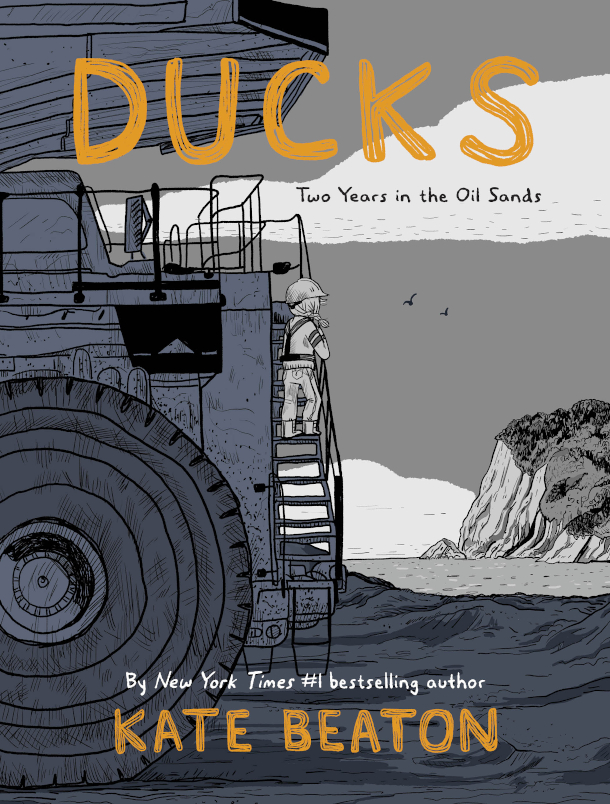
The cover of Ducks: Two Years in the Oil Sands. (Image: copyright Kate Beaton. Courtesy Drawn & Quarterly.)
The Athabasca oil sands in Alberta; Canada ranks as one of the world’s most destructive crude oil operations. People laboring in the Athabasca oil sands often live in austere work camps, with long 12-hour shifts and female workers imperiled by sexual harassment and violence. Kate Beaton captured that painful reality in her 2022 graphic memoir Ducks: Two Years in the Oil Sands and joined Living on Earth’s Jenni Doering to talk about her experience.
Transcript
DOERING: It’s Living on Earth, I’m Jenni Doering.
The Athabasca oil sands in Alberta, Canada have been called the world’s most destructive oil operation because it involves razing the boreal forest and then strip mining the oil-rich sands underneath. And a 2023 study from the government of Canada found that the greenhouse gas emissions from tar sands may be at least 65 percent higher than those reported by industry. In addition to these environmental and climate harms, the extraction of these fossil fuels has also taken an emotional toll on some of the people who work in the industry. They typically live in austere work camps and rotate through 12-hour shifts both day and night, in temperatures frequently below zero degrees Fahrenheit. And for the women who have sought employment in the male-dominated oil sands, the job can bring unwanted comments and sexual violence. That’s a painful reality captured in the 2022 graphic memoir “Ducks: Two Years in the Oil Sands” by cartoonist Kate Beaton. Please be advised that we will discuss sexual assault in this segment. Kate Beaton joins me now from Cape Breton, Nova Scotia. Welcome to Living on Earth, Kate!
BEATON: Thank you.
DOERING: So can you tell our listeners the story behind the title and explain why you chose it?
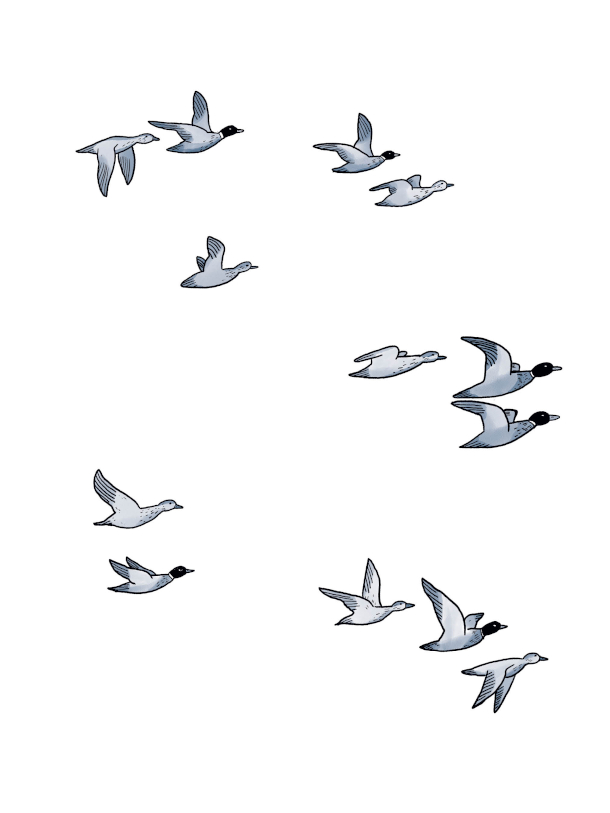
Ducks in flight. In 2008, around 1,600 ducks died after landing on a Syncrude tailings pond in Alberta. (Image: From Ducks: Two Years in the Oil Sands, copyright Kate Beaton. Courtesy Drawn & Quarterly.)
BEATON: Sure. The book is called Ducks. And there are a number of different things that you can take from that title. The main thing is that there was an incident in 2008, when I worked in the oil sands, when hundreds of ducks flew into a tailings pond at Syncrude, which is one of the sites that I worked at, and they died. And this became international news. And it was one of the first times where people really took a hard look at what was going on in the oil sands and decided that they didn't like it. When we were working there it seemed to be farcical because it was not as though those were the first animals that you saw that were endangered or dead because of the oil sands operations. And when you're reading the book, it's not the first animals that you encounter who have been impacted by these things. Around that same time, local Indigenous people were catching fish, and saying that they were finding cancerous lesions on them. And people were scrambling to find ways to discount that, to disprove it, to say, "No, I don't think so. I don't think this is what you think it is." And people didn't seem to care about the fish in the same way that they did about the ducks. Because it was easy to see that the ducks were all dead. But it was harder to admit that an entire watershed was poisoned. And these Indigenous communities were also reporting themselves to have high rates of cancer, rare cancers, things like bile duct cancer in their communities, in Fort Chipewyan and Fort Mackay, much higher incidences of those in their communities than you find in other places. And they're saying amongst themselves and to other people, you know, it's clearly linked to the oil communities. And people are bending over backwards to say "No, probably not." [LAUGHS] When it, when clearly the link is there. And how would you feel if people around you were contracting these rare cancers, and the government was trying to deny it, and the corporations were not claiming responsibility, and then they went out and made a gigantic fuss about these ducks? And everybody cared so much about the ducks? You know, you would, you'd be like, disgusted.
DOERING: Why did you decide to go work in the oil sands?
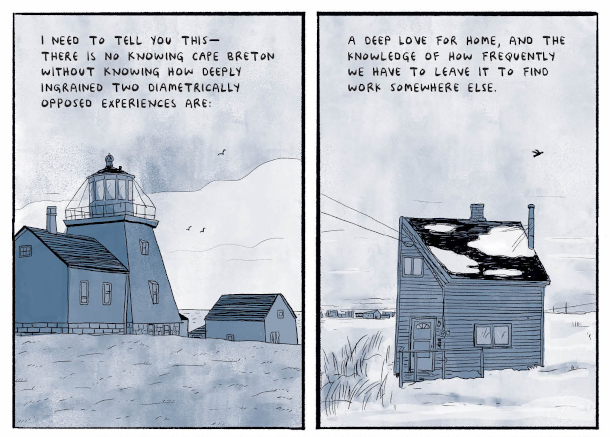
With $40,000 in student loans and no job prospects in her home of Cape Breton, Nova Scotia, Kate Beaton traveled West to work in the Alberta tar sands. (Image: From Ducks: Two Years in the Oil Sands, copyright Kate Beaton. Courtesy Drawn & Quarterly.)
BEATON: At that time, in 2005, that was the place where everybody was going to work. I had graduated from university, and I had this debt. It was only $40,000. But the truth is that I maxed out both the federal and provincial loans to get it. And it was more money than I could possibly fathom owing to anybody. And if I paid back only the minimum, I would end up paying it back so many times over in interest by the time I ended up paying it back. In Cape Breton, we had a pulp mill, we had Sydney steel, we had coal mining; all three of those were shut down by the end of the '90s. Those were major employers. And when you'd go to the guidance counselors in school, and you were like, "What do I do?" And they were like "Leave. There's nothing here." It felt like you had no options.
DOERING: There is this trauma of environmental health. And you describe some of the health issues that you had working at camp, and some of the perceived health risks. Can you tell our listeners about those and whether any of those have persisted?
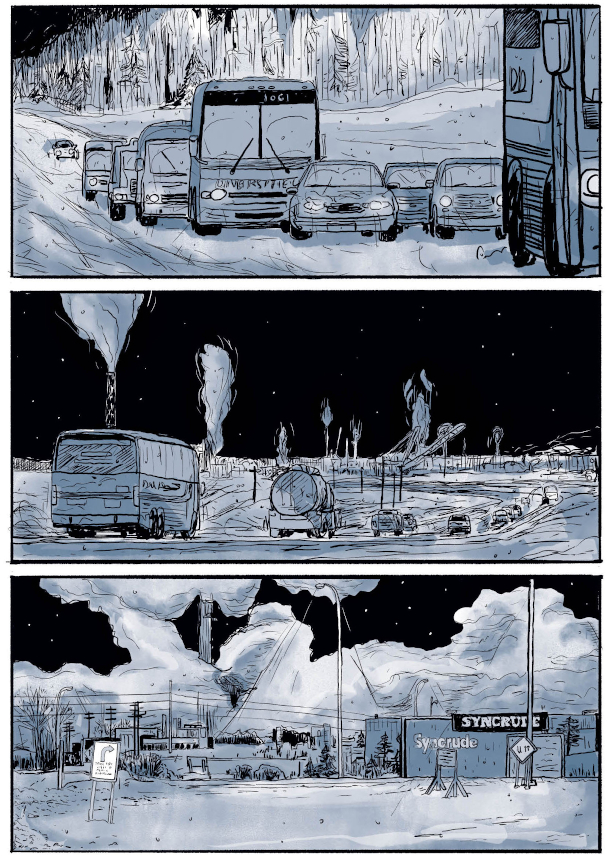
Traveling to the Syncrude oil sands mine (Image: From Ducks: Two Years in the Oil Sands, copyright Kate Beaton. Courtesy Drawn & Quarterly.)
BEATON: Oh, yeah, there were lots. I mean, I think the first thing I drew in the book was when you would come home and you, I would always, like, cough up this weird gobs of things. I didn't know what they were; you'd just cough up this phlegm. And you'd be like, "Well, that was whatever I was breathing in all day. Don't know what that is." And I would get these rashes, especially on my back. They were from, like, what I assume is whatever was in the air rubbing between your skin and your clothes. Because we would come to work in the morning, when I worked in the office, like you'd be gone just like overnight, or maybe a couple of days. And you'd have to, like you could take your finger and wipe the film of dirt off the computer screen. So you knew that there was just stuff flying around in the air. Like that doesn't happen in your house. But it's flying around enough in the air there that it's settling on your desk in a short amount of time. So, you must be breathing it in all day. And everywhere you went, the signs were like, "Non potable," like, the water is non potable. So you had to drink from jugs of water that they had. It was like, it was an active mine.
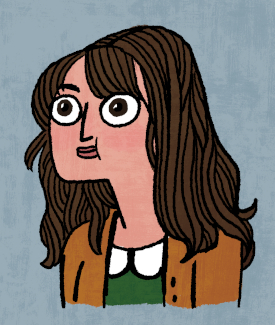
Kate Beaton’s comic self-portrait. (Image by permission: © Kate Beaton)
The dangers were everywhere. We would have meetings every morning, safety meetings about how to not slip and fall and how that kind of thing so that if we hurt ourselves on site, the company couldn't get sued. But we never talked about things that would happen in the long run. Because anecdotally, you hear about people getting cancer who worked for a long time at Syncrude or Suncor, but no one's going to trace that back to the company. And no one is going to do a study on people who were working in the camps. If they worked there for a decade, and they got cancer two years later, no one's going to link that back. And no one's going to do that study, because who's going to fund it? The Alberta government? Yeah, right. My sister got cancer. Several years after working on site, and she, she worked there for longer than I did, several years longer than I did. And she had cervical cancer. And that's not related to breathing in things, and. But it spread so fast through her body that you will always wonder.
DOERING: I'm so sorry about your sister -- Becky, I think?
BEATON: That's right.
DOERING: Yeah, she's a pretty important character in the book.
BEATON: Yeah. And we joked about getting cancer in the book. I wrote that line in there before we even knew she had it.
DOERING: During your two years working in the oil sands, you experienced sexual harassment and assault, which you depict in your book Ducks with the lead up, and then just jet black pages completely filled with ink. How did the experience affect you emotionally?
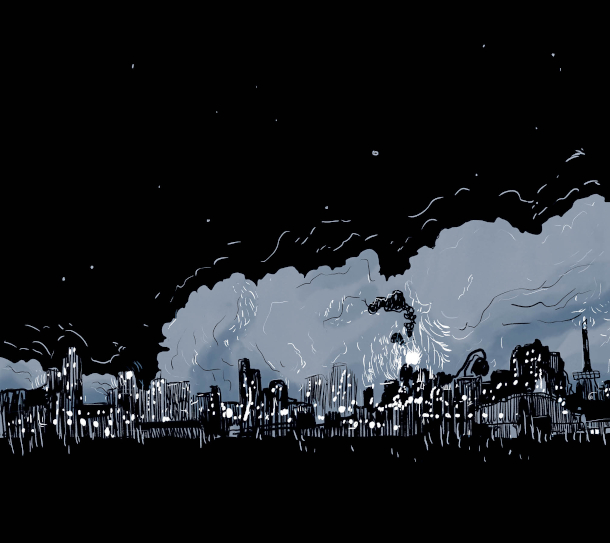
The Syncrude oil sands mining complex at night. (Image: From Ducks: Two Years in the Oil Sands, copyright Kate Beaton. Courtesy Drawn & Quarterly.)
BEATON: Well, there was the harassment on the job, in the heavily masculine environment. It was nothing like I had ever experienced before, and I was completely unprepared for it. And even if you think that, it's going to be bad, it's nothing like what it is in person, the relentlessness of it. Because you don't just work there, you live there. You live in the work camp; you get up in the morning, and you go to work, and then you go home at night, and you sleep next to everybody. You shower with them in the morning, you eat your meals next to them, and there is no escape from it. There are people who don't know that they make you feel unsafe. There are people who don't care that they're bothering you. There are people who think that they have a connection with you because they are lonely. And they don't know that you are desperate to get away from them. It's not like regular society at all. And it becomes so much your new reality that you become inured to how much danger you're in, you stop pushing back. And when I did complain to my boss, when I was in a situation that was unsafe, he told me that he had no room for people looking for special treatment, and I felt ashamed. It was a signal to never complain again. And you don't want to be anything but a good worker, you want to be seen as a good worker, you are there to do the same job as everyone else. And you want them to respect you. When an episode of, of actual sexual violence happens, in retrospect, it wasn't surprising, although I never saw it coming. And in fact, it happened twice in a row very quickly. I had stopped seeing the danger around me because it was everywhere. And I was like a shell of myself. So of course, this was traumatic. And I carry that with me to this day. But I do not think that the men who raped me consider their acts to be rape. We came out of that place with different memories of what happened.
DOERING: What kind of support did you feel that you had, or didn't have, you know, from official channels and also in your personal life when this happened?
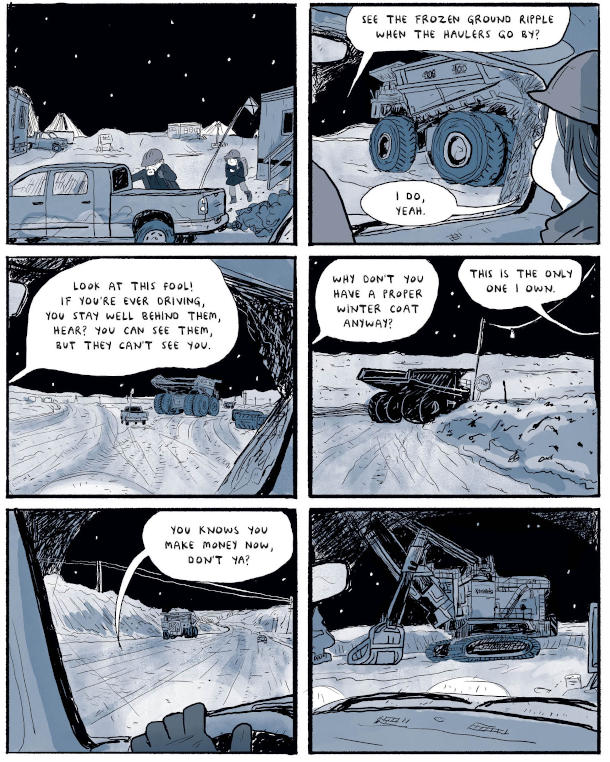
A panel from Ducks expressing the dangers of the heavy hauler trucks in the Athabasca oil sands. (Image: From Ducks: Two Years in the Oil Sands, copyright Kate Beaton. Courtesy Drawn & Quarterly.)
BEATON: [LAUGHS] There was no support from official channels. It was a place that prided itself on being a happy place for women to work. If you went to the website, you saw smiling women in hard hats and smiling people of color. It paid a lot of lip service to the idea that there was a zero-tolerance policy for things like harassment, which was just complete nonsense. But I did have support from my friends who were there. My sister was there, and my friend from university who joined me. And there were other female workers there, who you knew were going through the same things as you, and you could talk to them. I was lucky to have people who were close to me that I could talk to eventually. But it's not like it happens immediately, when something traumatic happens to you. You don't start processing it immediately. And that happens, I show it in the book -- it takes a while to talk about it and to understand my own feelings about it.
DOERING: Can you help me understand the way that you intersperse this image of bare feet on a shoreline throughout the book repeatedly? I think it returns again and again amid traumatic events. And it feels like it's kind of an escape or a balm for you, but I wanted to hear you talk about it yourself.
BEATON: Sure. That's the West Mabou beach in Nova Scotia. That's the beach in my home village. It's a very beautiful place. It's always peaceful. It's funny, growing up here, you can be like, "I need to get out of here. This place sucks!" In almost any kind of like beautiful, like bucolic rural space, the kids can be like, "I wish I went to, I wish I could go to a mall." Then you grow up and you leave and you come back and you're like, it's beautiful here. I see why tourists like to come here. [LAUGHS] You like took something for granted your whole life. And then you miss it so much. So these reoccurring images in the book of the feet in the water on the shoreline. It's kind of like, knowing where you're from, and where you're safe, and where you belong.
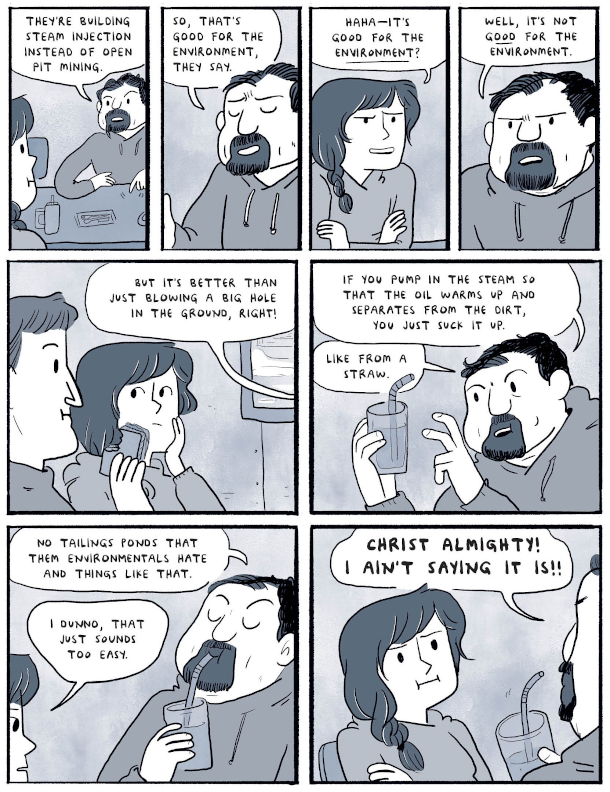
Steam-assisted gravity drainage is an “in-situ” oil recovery method in the oil sands. It requires heating steam, usually by burning natural gas, to force oil out from underground. (Image: From Ducks: Two Years in the Oil Sands, copyright Kate Beaton. Courtesy Drawn & Quarterly.)
DOERING: You managed to portray glimpses of beauty and wildness amid this grim landscape of the oil sands. Can you share what the Northern Lights and the pictures by your coworker represented for you there?
BEATON: The Northern Lights were beautiful. I had never seen them before. It was a night that was freezing. And they, they put me in a, in a shutdown shift, which is one where people are working overtime to fix this broken machine thing. And so I was alone in a tool crib. And it only had this tiny heater to heat it and it was minus 50 Celsius. And I don't know what that is Fahrenheit, but it's very cold. And a bunch of the workers had left a bunch of dirty tools outside and the bitumen had frozen on and I had to use degreaser to clean them all, but it was, they were all frozen. So I had to clean them really hard to get it off because it was so cold, but they were all metal as well, so they were all frozen solid. And my hands were just like popsicles. And all I had was that tiny space heater. So, I was laying on the floor next to it a lot of night as well. And I remember crying on the floor too, because I-- I never felt so alone. And then I walked outside to get another bucket of those tools. And I, I looked up, and the Northern Lights were above. And they were beautiful. And I took my helmet off. And I just I stood there staring at them for as long as the cold let me, because it was so beautiful. Before I left, there was a man, I called him Norman in the book. His name was Conrad Tabak. He had taken up photography as a hobby. He was like, "Everybody's got to have something to do here that makes them happy." He was a lovely man, an older, older man. And he went out when the Northern Lights were out, and he would go and take photos. And he was making blown up copies for people. He gave me one before I left, I still have it. It's downstairs. He was always looking for these beautiful things to take pictures of. But he died of cancer this year, just before the book came out. And I was so sad to hear that, because he was such a nice person. There were lots of nice people there. There were lots of nice people who looked for the beauty in things. It wasn't all terrible people. There were nice ones.
Cartoonist Kate Beaton (Photo: Morgan Murray)
DOERING: You now live back in Cape Breton, Nova Scotia. And I'm wondering what are things like there now, economically, socially, what does it feel like to be back?
BEATON: Well, it's different than when I left. It's not as bleak. Coal mining is gone; well, actually, they keep trying to bring coal mining back, but it's gone. Steel is gone. The pulp mill is back. But it's not the same as it was. The Internet has changed a lot, you know. We didn't have the internet when I left, really. But now, you know, people can work from home and they can start new businesses here. It really changes how a rural economy can operate when you have online options. And so someone like me can, I can work from here, whereas before I would have to live in a city or something like that, but I can, I can live here. There are more and more young people moving back, and people are hopeful about it. It's nice. And I'm glad to be part of that.
DOERING: Kate Beaton is the cartoonist author of "Ducks: Two years in the Oil Sands" and creator of the comic strip "Hark! A Vagrant." Thank you so much, Kate.
BEATON: Thank you, thanks for having me.
Links
Living on Earth wants to hear from you!
Living on Earth
62 Calef Highway, Suite 212
Lee, NH 03861
Telephone: 617-287-4121
E-mail: comments@loe.org
Newsletter [Click here]
Donate to Living on Earth!
Living on Earth is an independent media program and relies entirely on contributions from listeners and institutions supporting public service. Please donate now to preserve an independent environmental voice.
NewsletterLiving on Earth offers a weekly delivery of the show's rundown to your mailbox. Sign up for our newsletter today!
 Sailors For The Sea: Be the change you want to sea.
Sailors For The Sea: Be the change you want to sea.
 The Grantham Foundation for the Protection of the Environment: Committed to protecting and improving the health of the global environment.
The Grantham Foundation for the Protection of the Environment: Committed to protecting and improving the health of the global environment.
 Contribute to Living on Earth and receive, as our gift to you, an archival print of one of Mark Seth Lender's extraordinary wildlife photographs. Follow the link to see Mark's current collection of photographs.
Contribute to Living on Earth and receive, as our gift to you, an archival print of one of Mark Seth Lender's extraordinary wildlife photographs. Follow the link to see Mark's current collection of photographs.
 Buy a signed copy of Mark Seth Lender's book Smeagull the Seagull & support Living on Earth
Buy a signed copy of Mark Seth Lender's book Smeagull the Seagull & support Living on Earth

